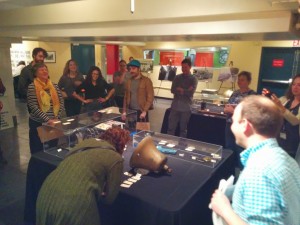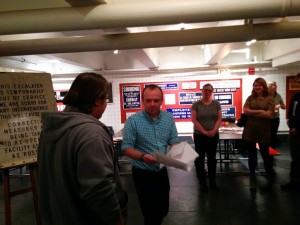By Brett Dion

How it all began
In the four years prior to that moment, I had happily toiled away on the cataloging of NYTM’s three-dimensional artifact collection. Coming across found-in-collection tools and parts of the infrastructure and business of urban transportation, then determining a general history or context, was a genuine pleasure. Just as finding out a concrete fact or two held meaning for a trained archivist like myself, I also walked off to lunch or to the evening ride home and free-associated about the unknown track worker who worked with a wrench the size of my arm or the engineer who performed conductivity tests on a sample of third rail.
Rob Walker brought all of that conjecturing back to the forefront for me. I could imagine putting a formal or informal writing group in a room with some of the less familiar and abstract artifacts, along with the definitive and iconic objects that are universally associated with NYC Transit history, and invite those writers to “story slam.” I came back from that AAM epiphany and shared the idea with a select few in management and our Education/Programming staff. I never considered it my job to execute such a program, but I wanted to support it. So for several months, I sporadically brought it up to those individuals to keep the idea alive.
The project picks up steam

Here was a chance for me to answer a solicited call for some programming ideas. Because I had stored up several, and discussed them informally over time, I was ready to easily hone them into the fine points of some proposals that ended up on paper. One of those ideas melded my familiarity with the artifacts collection, the Significant Objects project, and improvisational storytelling forums like “The Moth.”
Finding an audience

In early fall, with a date set for November 12th, 2014, the Collections staff sat down with Julia and we agreed to promote to student writers, museum collections professionals, community writing groups, improv schools and theaters, and NYTM patrons. With just a few weeks until the free event, we attracted more attention and RSVP’s by posting several images of objects and archival photos to the museum’s Tumblr page to prompt advance submissions. This also provided a way to participate for those not inclined to improvise on the spot or to read aloud. Those initial, online “totems” and the subsequent “pop-up” exhibit of 25 more for the museum program were selected by the in-house, ad-hoc production team.
The evening event

The improvised exhibit label-writing was a great entry point to get everyone’s creative writing flowing. A few guests did make the greater commitment to read their on-the-spot short story drafts. And several of the preliminary online submissions were read aloud.
Engaging with the audience – and the team!
We discovered, I think, a wonderful and malleable template for sequels to this program. I lean towards establishing a link with an undergrad writing program that would assure a core audience of peers who are likely to be comfortable sharing ideas and fragments of stories already. Then, the rest of the outreach could build on that alliance.
One other resonant and firsthand discovery for me was that I saw a great group of museum colleagues coalesce around this event. If we never did another one, I’d still be very proud of the team-building opportunity that grew out of this program proposal. Museums often can’t show off most of their collections to the world, but we know the curiosity is there. Collections and archives are arguably the most content-rich departments of a museum, but the other behind-the-scenes employees don’t get to see much of them. Internally, this program showed me that untapped curiosity and creativity in our versatile and trustworthy staff can be interpreted and shaped into the programming.
Terrific program and great way to channel public interest, and put collections into circulation in new ways.